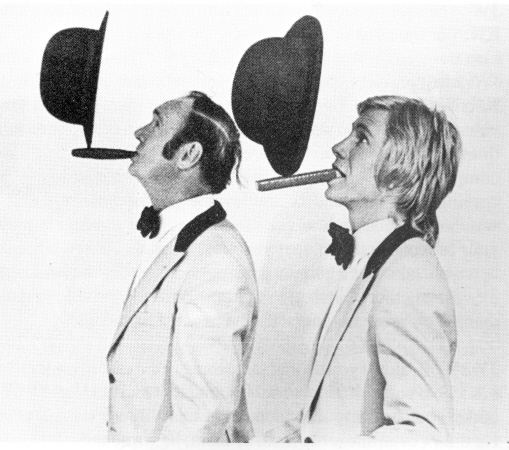
Bella Kremo and his son, Kris captured in a classic moment (Photo from Ziethen's "4,000 Years of Juggling"). |
Page 7 Summer 1989
|
JW:
Were there advantages to staying here for so long? KK:
The main advantage was that I could work on my act. The band knows
it in and out; the light people are all behind me. The management
was very nice and didn't give me any limits about experimentation.
Professionally that was a big plus. Also, I could live like a decent
person, and not out of a suitcase. I could enjoy the luxury of
having horses. My horse Silver Pages, a quarter horse Palamino
stallion, won a few prizes in halter showings.
My
family came by; that was one of the good things. Everybody who came
to Las Vegas stayed at my place. They called it the Kremo Hotel!
There was also horse riding, water skiing, skiing, tennis and
swimming. JW:
Your father performed until he was 65. Will you be
performing that long? KK:
If I stay healthy enough and if there's still show business around
at that time. But you don't know what opportunities will come. Who
knows? Maybe some business opportunities. I'm pretty flexible. I do
love performing best, though. JW:
Your trick of bouncing a top hat off your forehead before landing it
on your head, where did that come from? KK:
I never paid any attention to where it started, but I remember
practicing it. Top hats were very expensive and when they fall
a lot they break easily. If you take one that's not
reinforced you can break it in a single day! Because of that, my
father wasn't too keen about having me practice them a lot. He
finally built me a net around my waist attached to the wall. Every
time I dropped a top hat it fell in the net right in front of me and
I'd continue.
To
do it, you have to hit the rim of the hat at the middle of the long
side. When you hit it, hit it with the right force. There's only one
spot really where you can hit it to get it to somersault in the air.
Eventually, you learn the technique. I sometimes do five hits with
somersaults in between. I can do seven or eight sometimes, depending
on how lucky I get to hit it in the right place. I think the record
on stage is 12. JW:
Did you learn your top hat work early? KK: I actually learned the bouncing very late. I started balls earlier. then cigar boxes, and I didn't practice hats until I was 15 or 16, and that was just juggling and tossing them around. My father didn't let me do much hat bouncing even when we practiced together. He did that and I did the easier things.
I
was 23 when I started with the bouncing on my own. And then I didn't
like it. I never liked top hats, really, and never felt right
performing them. I just wasn't having any success with them. In 1976 I
decided I was going to take them out of the act. But a year later I
played in La Scala in Barcelona. It was a hard place to work, to make
any contact with the audience. I started to realize there I could get
the most contact with the audience with the hats. With the balls and
cigar boxes the music played through to the end and those routines
were set. But top hats were something I could pace myself through, put
some jokes in and play with the audience.
Then
it became very important to me. I was doing three top hats at the
time. It was basically the same routine as now, but with less
technique and no jokes. JW:
Did you ever feel like juggling
was hard for you to learn or boring or tedious, or did you go at
practice with vim and vigor? KK:
Well, later on yes. But at first, at age five it was very boring. My
father gave me some money for practicing that I collected in a little
box and used to buy cowboys and Indians. But later on it got more
interesting.
However,
I must say that I learned juggling the proper way. My father started
me and my brother and sister with one ball in one hand, I don't know,
a thousand times at three different heights-medium, high and small.
One ball and just throw it -- 50 medium, 50 high and 50 small. Then
from the right to the left and left to the right and this forever and
ever and ever. Then with two balls the same and three. That's how he
taught me four and five. By the time I was eight I did five balls. Now
I do them like once a year. Instead he made me practice ball spinning
and hoops and clubs. He gave me a choice of props, but told me boxes
and top hats would be a better business. JW:
Is that becanse those were his
main props.? KK: Yes, it's what he did, but it's other things. You can do those props for a longer time and they're more amusing. You can also work any place without worrying about height. When I was practicing at age 14 or 15, there were a lot of hoop jugglers and club jugglers and you always want to do something that's not like everybody else. It's easier to get a contract. |

Bella Kremo and his son, Kris captured in a classic moment (Photo from Ziethen's "4,000 Years of Juggling"). |